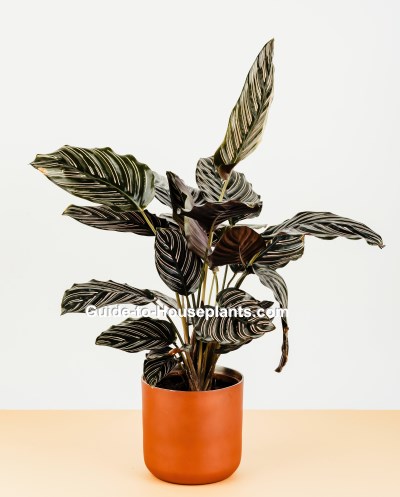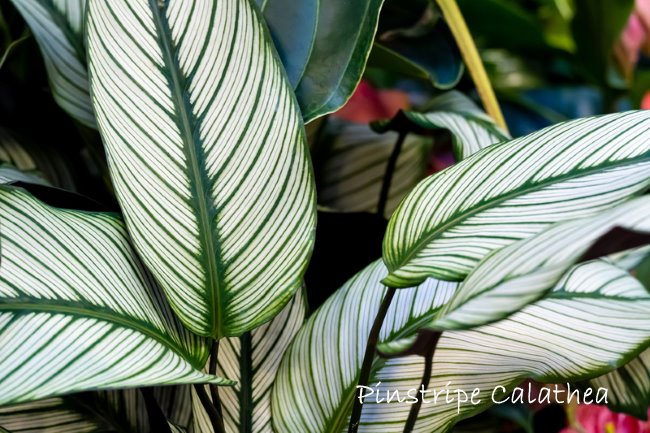Calathea Ornata
Botanical Name: Calathea ornata
Calatheas are a gorgeous family of prayer plants, and Calathea ornata is tough to beat. Just look at that stunning silver pinstriped foliage. Those large decorative leaves fold up at night, exposing their reddish undersides. When you open your curtains or blinds in the morning, you can watch the leaves unfold.
The key to keeping this beauty happy indoors is to keep it moist, warm and near indirect light. Think about its native rain forest habitat, where it is bathed in a mist and 70°C/21°C temps nearly all year.
Short of turning your home into a misty rain forest, there are a few easy ways to boost the humidity for your tropical plants. You can set a small plant on a humidity tray. If your home is really dry (especially during the winter months) your best option is to use a room humidifier with a cool mist.

Calathea Ornata Problems, Solutions and Answers
Brown leaf tips are caused by dry air. This South American plant thrives in high humidity. You have a few options here. If your home is dry, use a room humidifier. Grouping tropical plants together creates a humid micro-climate. Bathrooms are sometimes a good location for tropical plants because of the high humidity; but only if it has enough light streaming in. It's a good idea to use a humidity gauge near Calathea ornata, rather than guess. Indoor air can become extremely dry in winter.
Leaves not unfolding? Calatheas that keep their leaves folded up night and day are likely too dry. This rain forest native likes moisture -- don't forget to water and maintain humidity around it.
Leaf burn/dried leaves and stems are sometimes caused by a buildup of mineral salts from fertilizers. You may also notice white crusty deposits on the surface of the soil. If you've overfertilized your plant, leach it by slowly pouring lukewarm water over the soil several times, allowing the water to drain out the drainage holes. Leaching once or twice a year will prevent unsightly leaf damage; it's easy to do and only takes a few minutes. Just do it -- you'll have a much healthier houseplant.
Webbing between leaves is often the first tale-tell sign of spider mites. Unfortunately, these tiny critters will cause harm to your plant and often move on to your other indoor plants. Treat any infested plant immediately. Spider mites are attracted to dry conditions, making them more of a threat during the winter months when indoor air is dry. Raising the humidity will help to prevent them.
Wondering when to repot? When your Calathea plant outgrows its pot, move it up to a pot 1- to 2-inches larger. Spring is the best time, when the plant is starting its most vigorous time of growth. Don't overpot -- a common mistake with houseplants. Why? A too-large pot will hold too much water, which may lead to root rot. Always use a pot with drainage holes to prevent soggy soil.
Are Calatheas poisonous? No, they are non-toxic, making Calathea ornata safe in a home with cats, dogs and people.
 Photo © Ilja Enger Tsizikov | Dreamstime
Photo © Ilja Enger Tsizikov | DreamstimeCalathea Ornata Care Tips
Origin: Colombia, South America
Height: Up to 2 ft (60 cm)
Light: Bright, indirect sunlight. Hot, direct sun will cause leaves to turn brown.
Water: Aim to keep the potting mix lightly moist; never allow it to dry out. It's a good idea to pot your Calathea in a container with drainage holes. Water thoroughly, then empty the drainage tray to prevent root rot. Calatheas are sensitive to fluoride and salts in tap water, so I'd recommend using distilled water or rain water. Remember to always use lukewarm water when watering your houseplants; cold water is a shock to them.
Humidity: Prayer plants love high humidity, and this Colombian beauty is no exception. Try to maintain at 60-70% relative humidity all year. It's a good idea to use a cool-mist room humidifier.
Temperature: Average to warm room temperatures (65-80°F/18-27°C) year-round.
Soil: Peat-rich potting mix that drains well, such as African violet mix.
Fertilizer: Feed monthly spring through fall with a balanced (such as 10-10-10 N-P-K) water-soluble fertilizer.
Propagation: Leaf cuttings can be taken in spring. Keep cuttings warm, moist and in indirect sunlight for best results. Clumps can be divided and potted separately. Calatheas are not easy to divide, so wait until the plant is large before you try separating it.


